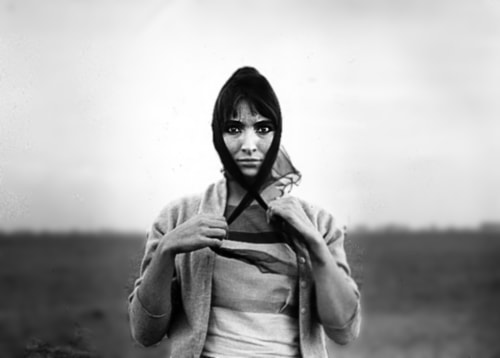
An enigma with many aliases, the consummate witness never seen, Chris Marker remains one of the strongest voices of postwar cinematic image-making. Although even his most ardent fans will never have a clue as to who he really is, he has helped us as a culture to understand a little better what we may be. Radical beyond the most provocative of French philosophes, as irascible and evasive of expectations as his compatriot Jean-Luc Godard, Marker took a gradual turn to photography, new media, and installation work beginning in the mid-1990s. The move has proven as poetic and confounding as his most celebrated films, from La Jetée (1962) to Sans soleil (1982).
The exhibition Staring Back was organized by Ohio State University's Wexner Center (which also commissioned Marker's mesmeric video-meditation Silent Movie in 1995), and brought to New York last fall by Peter Blum. The show is Marker's personal journey through more than fifty years of photographs. Neither a biographical history nor a gathering of greatest hits, this collection reveals the auteurs struggle against the forces of sequence and linearity -- those forces that tether us so inextricably to narrative -- and the fierce conviction that has made his movies such gems of essentialist meaning.
Marker is both the most, casual and the most causal of formalists; meaning constantly struggles against explanation, representation is reduced to almost metaphorical abbreviations. He has maintained a profound resistance to his seminal role in cinema vérité by tracing truth as a kind of sociopolitical disappearing act. He is an itinerant aesthete who has wandered the spectacle with the acuity of Guy Debord, tripped across media with dilettantish ease, gazed upon every woman for her impossible quotient of beauty, found humor where few would look, chased the Cheshire cat for the riddle of his grin, looked unblinking at the best and worst of the human condition, and always questioned the presumption of authority. Marker locates himself through photography, and when he does he is even more Proustian than at every other step of his career: Staring Back is about memory as much as mortality in his retrospective years. Like nearly everything he has turned his hand or lens to, Marker's new-old photographs are memorable precisely because of all the things he refuses to forget. And to complicate this, it would seem that he is most compelled by the frailty of memory. Forever forging surrogates (he's used many pseudonyms -- "Chris Marker" being one of them -- constantly crafting clever constructions that dangle like suspended fictions in a metanarrative), he has even refused to comment on his most famous work, saying: "If I were to speak in the name of the person who made those movies it would no longer be an interview but a séance."
There is much about Marker's Staring Back that reads as yet another confrontation with the idea of authorship. Most striking in this is the utter lack of concern (or is it pretense?) toward the fine art of photography. It does take a special logic to produce amazing images as third-rate prints: it is a trademark modesty that at times seems more a conceit. Nearly two hundred pictures in total are culled from over five decades, some from his extensive cinematic oeuvre, and others presumably his own photographs -- the former most often mediocre-quality screen-grabs, the latter his almost anti-documentarian precept of history as interstitial.
Staring Back is about the intensity of looking and the anticipation of not knowing -- wishing to, of course -- and imbued in the mystery and curiosity of eye-contact with intimate strangers. Divided into four sections (directed by the predominant themes "I stare" and "They stare") the room is filled with Marker's inimitable absence. Photography is about reflection; the subjects are registered here in the artist's eye, and powerfully in how they in turn look back at him. There are some famous faces among these portraits, including Simone Signoret and Akira Kurosawa, but anonymity is the general rule (as it must also be for most who would have no idea of who this man behind the camera is), presiding over Marker's perpetual capacity to measure the personality of a crowd or of any individual. He is a natural hybridist (his movies often include still photographs), and his boundaries are indeed global, spanning continents and cultures with the same epic scope as that of his journey through time. In such a personal show, Marker remains a riddle to the end. You can see clearly that he loves humanity despite all its failings; he's never made a secret of caring. One odd bit, in noting how seemingly uninterested he was in the aesthetic presence of the photographs themselves, Wexner curator Bill Horrigan confided that. Marker's decision to pursue cinema was directly informed by his realization that he could never be as good a photographer as Robert Frank. A modest measure from an artist whose greatness we have yet to fully fathom.
- CARLO McCORMICK
Chris Marker: Staring Back was presented at the Wexner Center Galleries. Ohio State University, Columbus. May 12-August 12, 2007, and at Peter Blum Gallery, New York City, September 8-November 1, 2007.